September Division2 P416 King Again Eb Dead
" The Strategic Homeland Division (SHD) is a decentralized, autonomous entity endowed with executive powers and rules of engagement unfettered by legal constraints. Trained to operate in mortiferous CBRN (Chemical, Biological, Radiological, Nuclear) environments, The Division is mandated to bring order, stability and justice to communities shattered past catastrophic events. The agency too pledges active support to classified Continuity of Government plans should a widespread national disaster cripple normal governing functions. "
The Strategic Homeland Division (SHD), referred to as The Division, is a classified unit of highly trained, cocky-supported tactical agents appearing in Tom Clancy's The Division and Tom Clancy's The Division 2. The players accept the role of Partition agents.
They are fully autonomous field operatives trained to restore order to communities suffering from catastrophic events, institutional plummet, and societal breakdown. Division agents are embedded in society, leading ordinary lives until they are activated. The Sectionalisation is not an elite unit in the traditional war machine sense. They are a civilian agency whose members practise not train or deploy like military units. Elite military forces are trained for specific tasks with a completely unlike mission specification than that of The Division. The Division is made unique by its connexion to Directive 51 and its interconnected but autonomous networked system. It is The Division as a whole that is special, not necessarily each individual agent. Officially, agents of The Partitioning are counted as federal agents, in direct service of the United States federal government.
Their motto is: Extremis Malis Extrema Remedia (Literal translation is "Farthermost Evil, Extreme Remedy". More unremarkably translated as the saying, "Desperate times call for desperate measures").
Contents
- 1 Origins
- ii Presidential Directive 51
- iii Recruitment
- 4 Pre -Testing
- 5 Training
- 6 Embedding
- seven Construction
- 8 Departments
- 9 Activation
- 10 Activation & Deployment
- 11 The Division deployment programme: A.N.S.West.E.R.
- 12 Field Operations
- xiii ISAC and The Network
- fourteen Rules of Appointment
- 15 Tactics
- xvi The Get-Handbag
- 17 Protective Equipment
- 18 Weapons
- 19 Base of Operations
- xix.1 Base Types
- xx Known Division Agents
- 21 Part in The Partitioning
- 21.ane The First Wave
- 21.ii Infighting and Going Rogue
- 21.3 The Arrival of the Second Wave
- 21.4 Role in The Segmentation 2
- 22 Relationships with other organizations
- 22.1 JTF and the First Wave (New York)
- 23 Partition Agents
- 23.ane Partitioning Commanders
- 23.ii Dark Zone Vendors
- 23.3 Rogue Agents (Concluding Human Battalion)
- 23.four Rogue Agents (Histrion Characters)
- 24 Gallery
- 25 Trivia
- 26 Appearances
Origins
In 2001, two important events triggered further refinement of the Continuity of Government concept in the United States. In June of that year, federal agencies conducted a high-level simulation called Operation Nighttime Wintertime to test the nation's ability to respond to a widespread bioterrorist attack. The practise featured a mock release of smallpox virus targeting Oklahoma City and two other locations in Georgia and Pennsylvania. The purpose was to evaluate national-emergency response protocols and the U.Due south. healthcare infrastructure in the face of such a lethal threat.
The results were sobering. Decision makers at all levels were remarkably unprepared. Woefully inadequate "surge capacity" in the healthcare system meant hospitals were quickly overwhelmed. According to the official mail-exercise report, Nighttime Winter likewise exposed major "fault lines" betwixt local, state, and federal government, every bit well equally betwixt public and private sector responders. Key agencies such as the National Security Quango failed to determine the origin of the attack or contain the spread of the virus. Response times were as well long, with a complex web of legal concerns slowing downwards logistics. Poor messaging and coordination with media outlets accelerated the panic, speeding the imitation transmission of the virus.
Such failures would likely produce devastating real-world consequences. The event scenarios included massive civilian casualties, large-scale breakdown of basic services, and widespread mob violence. Again, Night Wintertime was just a simulation. Merely on September xi, 2001, a small band of armed terrorists with an improbable program executed attacks that killed thousands of Americans, paralyzed the U.S. government, shut downwardly the country'southward aviation filigree for days, and deeply rattled the national psyche. As the nine/11 attacks unfolded, U.Southward. President George Due west. Bush fearing additional attacks, initiated COG measures and activated the old Cold War protocols. A reserve government, hidden in a cloak-and-dagger location, was on constant readiness in case a decapitating strike wiped out federal leadership.
Presidential Directive 51
On May 4, 2007, President Bush signed National Security Presidential Directive 51 (NSPD-51). This mandate claimed the executive power to invoke and direct Continuity of Government procedures in the result of catastrophic emergency. NSPD 51 construes such an emergency as "any incident, regardless of location, that results in extraordinary levels of mass casualties, impairment, or disruption severely affecting the U.S. population, infrastructure, environs, economy, or authorities functions."
The unclassified portion of the directive was posted on May nine to The White House website with lilliputian fanfare and no press conference. But NSPD 51 too included a set of highly classified continuity annexes, undisclosed to Congress or the full general public for what the executive co-operative deemed "national security reasons." Ane of those annexes ordered the establishment of the Strategic Homeland Division. Created as a direct response to the Operation Dark Winter findings, The Sectionalization reports directly to the president and is tasked with maintaining lodge in farthermost CBRN (Chemical, Biological, Radiological and Nuclear) environments in accordance with Continuity of Regime plans. Once Directive 51 has been invoked, the president tin activate The Segmentation's highly trained corps of sleeper agents embedded beyond the nation and immediately commence operations.
In late 2014, an Ebola outbreak created a significant scare in Dallas, Texas. Misstatements on travel documents, misdiagnoses, and other mistakes led to ii deaths and a rash of lawsuits. Breathless news reports fanned fears not just in Dallas merely nationwide. The incident highlighted the fact that, despite more than than $60 billion invested in bioterrorism readiness since 2002, the Us government still struggled to handle a small viral outbreak... and was remarkably ill-prepared to handle a mass-contagion scenario. As well on stark display in the media coverage: how thin and precarious is the line that separates a well-informed public from mass hysteria.
In response to the Dallas events, the executive branch tapped into its top-underground "black upkeep" (estimated to be $80 billion per year) and reallocated significant funds to increase the operational readiness of the Strategic Homeland Sectionalisation. In turn, The Division ramped up its covert recruitment and training activities.
Recruitment
Agents of the Strategic Homeland Sectionalization are fully autonomous field operatives trained to restore order to communities suffering from catastrophic events, institutional collapse, and societal breakdown. Division agents are embedded in gild, leading ordinary lives until they are activated. The Segmentation is not an elite unit in the traditional armed forces sense. They are a noncombatant bureau whose members practise not railroad train or deploy similar military units. Elite military forces are trained for specific tasks with a completely unlike mission specification than that of The Division. The Division is made unique past its connection to Directive 51 and its interconnected just autonomous networked organization. Information technology is The Division as a whole that is special, not necessarily each individual agent.
The ultimate Division agent is loyal, versatile, able, and fit. A expert immune organization, a proven ability to think on your feet, and the mental fortitude to make the tough calls are essential.
They are pragmatic and direct, capable trouble solvers with a natural curiosity and ability to take activeness.
Every Partition agent is expected to possess a self-sacrificing, "get-go responder" mindset, 1 that places community above cocky. To this cease, candidates typically accept some background in community-oriented or protective services: healthcare, military machine, or police enforcement; security, rescue or intelligence work; or some combination thereof. Just across this service preference, the Strategic Homeland Division seeks agents who come from all walks of life.
Field agents of The Division execute a wide range of tasks, both civilian and war machine in nature. They must be creative, versatile, contained, and capable of operating outside standard rules of appointment. As autonomous operatives, they are gratuitous to determine their mission priorities, operational posture, and level of visibility. Agents are bound simply by their oath of service and regulated only by the Internal Diplomacy co-operative of The Partitioning'south Operations grouping.
The Division is granted priority access to a vast reservoir of restricted data on citizens collected by the United States intelligence community. This access lets Division recruiters identify a sizable pool of prospective agents with suitable backgrounds for service. Candidates are drawn from all aspects of gild and are not limited to a specific skill set or profession.
In one case a candidate has been targeted, a highly classified vetting process begins. Internal Diplomacy conducts a groundwork check, including comprehensive financial and medical profiles, piece of work history, and online tracking, followed past extensive active surveillance of the candidate and his/her social network. If the target's portfolio survives this meticulous preview stage, a seasoned Partitioning agent finally makes contact to set up a preliminary interview.
At this point, the candidate must display a keen interest in national service and a willingness to accept absolute restrictions of secrecy - i.e., no 1, not even spouse or family, can know about The Division. And then comes a rigorous round of follow-up assessments. Only when this pre-testing is successfully completed tin can the candidate finally exist considered an official "recruit."
Pre -Testing
In one case a qualified and willing amanuensis candidate is found, Division recruiters movement to the side by side stage, chosen pre-testing. Agency psychologists deport intensive personal interviews, administer cognitive and psychological assessments, and closely monitor performances in VR mission simulators that assess reactions to a wide variety of Directive 51 scenarios.
Based on the results of this testing, recruiters develop a comprehensive Candidate Evaluation Report for every prospective amanuensis. On this report, recruiters measure the candidate's core skills by generating accomplishment scores for the following essential categories:
- Loyalty
- Mental resilience
- Judgement and decision making
- Field leadership
- Adaptability
- Problem solving and ability to improvise
- Technical skills/aptitude
- Commitment to peak physical fitness
- Allowed-arrangement wellness
- Raw survival instincts
Mental strength is fifty-fifty more than important than concrete forcefulness because at the end of the solar day, survival and crisis direction is a mind game. While non all candidates have actual combat feel, every agent must showroom the aptitude to train and set up for the worst case imaginable.
Grooming
Recruits who pass pre-testing begin full physical and technical readiness grooming. Bringing a new Sectionalisation agent up to mission-fix condition can be a tricky endeavor, withal, given the agency's secrecy requirements. The procedure is intensive and highly demanding, yet it must non put trainees in situations that agitate suspicion or threaten to compromise their cover. Therefore, nigh training activities are folded into a recruit'southward mean solar day-to-24-hour interval life, cleverly disguised as common civilian pursuits.
Examples: Unarmed lethal combat education may exist billed as an exclusive "black-belt-only class" at a neighborhood martial arts studio. Fitness regimens may be high-intensity "gold-level workouts" at a local cantankerous-training gym with special instructors (who happen to be Sectionalization trainers). Agents might register for avant-garde firearms classes at a nondescript shooting range, or enroll in "continuing teaching" technology courses at their local community college—over again, all taught by Division experts and attended only by other recruits or agile agents. The Partitioning works with every agent to develop constructive, apparent embrace stories for these activities.
To further protect The Division'south clandestine status, new agents are brought into The Segmentation's fold slowly. During the starting time six months of preparation, each recruit is reevaluated weekly for progress, including mental strength and psychological stability. Well-nigh recruits train under top-tier operatives for nigh a full year before condign privy to The Partitioning'due south true purpose and mandate.
Successful trainees eventually earn peak security clearance, and are certified by Internal Diplomacy as active field agents. All the same, grooming continues twelvemonth-round for the entire length of an agent'due south service in The Division. During peace time, all agents maintain and better basic skills - survival, gainsay, CBRN—knowledge, intelligence gathering—through regular practice and exercise. The principle backside this concept of service has active members devoting non-work hours to training and preparation. To this finish, the Division's Support department contracts civilian instructors to provide specialist preparation and conduct advanced group exercises of varied scope each twelvemonth. In addition, each local cell of sleeper agents is encouraged to coordinate and conduct regular, self-directed exercises and grooming sessions as they come across fit.
Embedding
Once the initial training is complete, new Division operatives simply go on on with their daily lives, performance as normal members of social club. Adapted from the concept of the "stay-behind" project enacted past the CIA during the Cold War, agents live where they will operate once activated, negating the demand for centralized mobilization and redeployment. Since Division agents are drawn direct from and embedded into the social club they will protect, they can be spread out across the country. Until activated, agents work in a wide diverseness of regular civilian jobs - police, paramedic, software engineer, lawyer, instructor, corporate manager - jobs that give them local insight and inform their tactical decisions in a crisis. They could be your neighbor, your role co-worker, your doctor, or your yoga instructor.
Being "embedded" this way tin be a challenging experience, specially for any amanuensis with a shut network of family and friends. Again, both The Division's existence and the amanuensis's status must remain ironclad secrets, kept fifty-fifty from loved ones. As noted, this is made trickier by the bureau'due south requirements for ongoing training and personal development.
Construction
On the organizational chart of the U.Due south. federal government, the Strategic Homeland Sectionalization is formally listed equally office of the Section of Homeland Security. However, The Division reports direct to - and only to - the president of the United states. The Sectionalization may commence field operations only when activated by the president pursuant to National Security Presidential Directive 51.
Led past a board of directors, the Partitioning's internal organisation is decentralized, based on the assumption that a major disaster or assail could neutralize a single central facility. To avoid such a decapitating strike, the "Dominion of Three" is applied: the agency's headquarters are housed in three identical and independently operated bunkers chosen "Cores." Located in Texas, Kansas, and South Dakota, these Cores are deliberately redundant and distributed across the nation's heartland to better ensure survivability in case of catastrophe.
Each Core is configured to handle routine management and administrative duties during peacetime but can transition instantly after a Directive 51 activation to coordinate intelligence and logistics across The Division network. Each Core is managed by a director with a seat on the board.
Departments
The Division features three separate departments: Research & Development, Support, and Operations.
- Enquiry & Evolution (R&D) : The Sectionalization'due south R&D department builds and supports high-level technical solutions for all agency field personnel. Responsible for the evolution of proprietary SHD technology - internally referred to as "Shade Tech" - the R&D group besides maintains the agency'due south arsenal of weapons, field equipment, and custom tac-ops gear. To retain its covert status (and avoid intrusive political oversight), Division R&D operates out of a consortium of dummy companies. This co-operative is always agile.
- Support : The Division's Support group handles routine tasks related to organizational management such as communications, finance and human resource. However, Support likewise performs primal mission-critical functions such as intelligence analysis and logistical planning. Basic office administration functions are always active, whereas mission back up activeness ramps up just afterward a Directive 51 invocation.
- Operations : The Operations department coordinates the deployment and field work of its cadre of highly-trained sleeper operatives known as "agents". Segmentation agents are embedded in civilian communities across the United States. Other than tiptop-secret covert grooming exercises agents do not engage in field work until Directive 51 is invoked and the president of the Usa activates them. Operations is divided into three branches: Internal Affairs, Strategic, and Tactical.
Activation
When the president invokes Directive 51 and activates The Division, a outset moving ridge of agents emerges from sleeper condition. This alpha team mobilizes at a designated rally point for insertion into the hot zone.
Once activated and deployed, a Division agent formally outranks all other tactical units in the field. This superseding potency lets Division teams cutting through red-record and featherbed policy restrictions, laws, regulations, and jurisdictional boundaries as needed. Agents can freely organize local assets, civilian or military machine, to address local needs.
One time activated, The Division's primary job list includes the post-obit:
- Restore civil order and preclude societal plummet.
- Facilitate restoration of bones services such equally ability, water, communications, and medical intendance.
- Interdict acts of insurrection, rebellion, or lawlessness.
- Provide tactical management and support for local police and military units.
- Collect field intelligence for key decision makers.
- Rescue, protect, and/or provide safe escort for high-priority individuals.
- Procure, protect, and disburse critical supplies: food, h2o, fuel, medical, and war machine.
- Comport robust counterterrorism operations.
- Coercive operations confronting sure actors of violence.
- Operations to control violence toward other actors who are not identified and can oppose a search for a solution.
- Humanitarian operations in favor of the populations.
Activation & Deployment
The official "call to action" for Strategic Homeland Partitioning agents unfolds in two phases: activation and deployment. Once activated and deployed into the field, Segmentation operatives answer directly to the President of the United States (as mandated past Directive 51) and outrank all other federal and state actors.
Their primary tasks are to observe the furnishings of the crisis; relay those observations to cardinal decision makers in the federal command structure; protect what remains of civilized gild, including social institutions as well every bit physical infrastructure; and prevent additional damage past engaging rising threats.
According to Presidential Directive 51, the President of the Usa can mandate activation of the Strategic Homeland Division in the event of any catastrophic emergency. Directive 51 officially defines such an emergency as "any incident, regardless of location, that results in boggling levels of mass casualties, damage, or disruption severely affecting the U.Southward. population, infrastructure, environs, economy, or regime functions."
The Catastrophic Emergency Response Agency defines a catastrophic emergency this way: "A large-scale issue with complex, far-reaching consequences that persist over the long term. Societal infrastructure is damaged or destroyed." The agency goes on to characterize such an outcome with a list of specific effects:
- Most or all customs structures are afflicted, including emergency response facilities.
- Local response is compromised or fails due to the loss of personnel and/or facilities.
- Aid to the region is non possible because all neighboring areas are affected.
- Everyday community functions are totally interrupted.
- Destruction of local and regional infrastructure ways national government must take charge—if is withal intact and able to exercise so.
Most scenarios that autumn under this definition of catastrophic emergency are straightforward in nature:
- Nuclear attack
- Invasion past a strange ability
- Big-scale terror outcome - e.g., bioweapon or radiological attack in blastoff-level city
- Natural disaster
- Pandemic
- Overthrow or seizure of the state apparatus by insurrection d'etat
These categories certainly encompass well-nigh events that typically would be considered "catastrophic": a major convulsion or hurricane; an ocean-basin tsunami (rated as "devastating" at 9 or college on the 12-point intensity scale); a nuclear exchange; a killer flu pandemic; a "dirty bomb" detonation; a full-scale strange invasion; or a military coup triggering a widespread breakdown of institutional authority.
In the case of the Green Poisonous substance attack on Blackness Friday, the catastrophe marks the convergence of two scenarios: a terror event (category A bioweapon) that expands into a widespread smallpox pandemic.
Activation tin can curl out in ii means: either equally an incremental attempt, where the response is gradually ramped up in waves over fourth dimension as a crisis intensifies; or it can exist a synchronized call-to-arms, summoning all available operational avails at once.
Every Partitioning agent recruit who successfully completes field preparation and achieves active-duty status is issued an SHD SmartWatch. The vesture-able device is a touchscreen PDA (Personal Digital Banana) and communications relay linked to a powerful transceiver worn on the agent's backpack. This digital gearset connects the agent to the Division's encrypted, satellite-based worldwide network.
When ending strikes, The Division rallies its embedded forces via the network. The global-matrix SHD Network features guaranteed, instant and ubiquitous admission to all SmartWatch devices. No matter where they are, Sectionalisation agents receive their activation orders as a coded emergency signal that lights up their watches orange. The watch retains this orange glow until later on the amanuensis is killed or deactivated.
Activated agents gain firsthand admission to high-tech equipment and advanced weaponry stashed deeply in secret local caches. When activation is signaled, agents must drop whatever personal task is at manus and proceed immediately to the nearest Division armory to gear up.
Once fully equipped, Segmentation agents head to either a predetermined rendezvous site or a tactical location designated in the activation orders. In either case, the agent's SmartWatch guides him/her to the targeted location via augmented reality (AR) markers seen in the heads-upwards display (HUD) in the amanuensis's special ScanTek contact lenses.
The Sectionalisation deployment plan: A.N.Southward.West.East.R.
Once Sectionalisation agents arrive at their designated destination, the first objective is to resolve local aspects of the catastrophic crisis scenario. Every field amanuensis is always dark-green-lighted to operate with full autonomy, free to prioritize urgent needs according to their training and rules of engagement. But agents typically look to seize the initiative in accordance with the Division's flexible deployment plan. This programme is chosen A.Due north.S.W.Eastward.R., an acronym that stands for the following:
- A CTIVATION - The number of Division assets activated is based on the nature of the disaster and its current condition. When activated, agents may receive further direct orders. But in nigh cases, they are expected to assess the situation and so either proceed to the next step of the A.N.Southward.W.Eastward.R. protocol or take initiative and follow an autonomous course of action.
- N ETWORK - The Sectionalisation'south get-go and foremost postal service activation task is to secure its SHD Network, the lifeline that allows all Sectionalisation echelons to share disquisitional information for long-term operations. While Tactical Division agents institute the network's functionality and generate the raw field intelligence, a highly trained squad of Strategic SHD analysts process and present a daily briefing to key individuals within the government. Big-urban center mayors, country governors, on up to the president and his cabinet - all key elected officials and decision makers rely on Division intel to make sure all operational responses are based on a true and shared picture, as reported live in the field.
- South ECURE - One time the SHD Network is operational and intelligence is flowing, the deployed Partitioning team typically takes upwardly a defensive posture to secure the immediate area and establish a safe and stable Base. Once a base is in place, The Sectionalisation can more hands interdict ongoing hostile activity and safeguard what remains of the locality's primal assets. This includes protecting critical infra-construction (bridges, roads, tunnels, water supply, electrical filigree), evacuating endangered officials and civilians, and clearing out chancy areas. Again, the freedom and ability provided by Directive 51 means that agents tin movement nearly unhindered and outrank all other officials in the field.
- W ATCH & EXPLORE - Once the local civilian population, leadership, and public infrastructure is secured, Division agents may and then push button out further into the field. Standard procedure is to explore the scope of the disaster, observe the extent of social disruption, and codify offensive operations confronting predatory or hostile groups.
- Due east NGAGE - In situations where laws, jurisdictional matters, or rules of engagement might hold dorsum other law enforcement entities, Division agents are authorized to resolve problems directly and, if necessary, with extreme prejudice. As before long equally a threat to the nation or its people is detected, The Segmentation may engage without hesitation or restraint.
- R ECOVERY - In one case an area is secured, recovery efforts begin. The Division coordinates intelligence, security, and advisory aspects of this work while leaving the difficult labor to other departments and agencies.
Field Operations
The Strategic Homeland Segmentation's organizing principles on the ground are flexible and modular. Agency field tactics are based on the core doctrine of "democratic action" - that is, every Segmentation agent is trained to operate independently in worst-instance-scenario environments with trivial or no direct back up. Nonetheless, agents likewise receive extensive grooming in small-grouping tactics, and often deploy in teams. A cooperative team of agents is referred to equally a "cell."
When working cooperatively, agents typically deploy in cells of upward to 4 members, oftentimes supported by a remote-operated drone. Cellmates know each other well. They tend to railroad train together and even socialize in their noncombatant life; they're familiar with one another's tactical and personal tendencies.
As e'er, the underlying forcefulness of whatever jail cell is the fact that it lives in the area where it operates. Not just are jail cell members already in place when the disaster strikes, but they're familiar with the local utilities filigree, know the lay of the state, and have a proficient take on people, places, and potential problems.
All the same, cells generally take limited sensation of other agents or cells operating in the field, even in the immediate expanse. Maintaining such strict unit compartmentalization may seem counterproductive, but preserving tactical autonomy in this mode helps go along The Segmentation resilient and less sensitive to outside disruption.
No predetermined rules dictate how cells self-organize and operate. Some choose to assign complementary roles - due east.thousand., forward recon units supported by suppressive fire and a medical expert; or shut-range specialists wielding shotguns supported by long-range marksmen with sniper rifles. Other cells feature more flexible roles, with members switching functions on the fly equally new situations dictate. In a crunch expected to be fluid and unpredictable, tactical decisions like this are left to each cell based on its mix of expertise, training, temperament and wits.
ISAC and The Network
Access to the SHD Network is ane of the most of import tactical tools in any Division agent'south toolset. Every field operative is linked via his/her personal Intelligent System Analytic Reckoner (ISAC) to the agency'southward powerful distributed computing network. Organization output is routed globally through an array of dedicated, hardened intel satellites in geostationary orbit. Thus, lack of network access is rarely a trouble.
These sophisticated networked systems automatically rails and record every Division amanuensis's progress, logging every encounter and generating field data to create a shared picture for informed assay at all levels of the COG decision-making appliance.
Ane of the SHD Network's most critically important tactical functions is to provide Division agents with timely identification of units during field encounters. Linked via SmartWatch to the agent's ScanTek contact lenses, ISAC draws from network databases to generate a nearly flawless, color-coded Friend or Foe (FoF) recognition system. This system displays the affiliation and current status of units directly onto the agent's HUD. In the rare example when the network goes dark and the FoF system does non work, agents are reminded to proceed with extreme caution.
Rules of Engagement
The Strategic Homeland Partitioning'south directives specifying the circumstances and limitations nether which its field teams may compel compliance by unwilling or resisting subjects, interdict actions by destabilizing players, or appoint outright hostile organized forces in combat are wide past design and purposely nonrestrictive.
Division agents are not bound past whatever local use-of-force continuum or policy. They cannot exist held accountable past local, land, or fifty-fifty federal laws or regime based on whatever legal standards other than those delineated in the continuity annex of Directive 51. In other words, nobody has the authority to stop or interfere with a Sectionalisation amanuensis in the field other than another Segmentation agent.
While agents may compel assistance, coordinate joint response efforts, resolve conflicts or jurisdictional disputes between police enforcement and/or war machine entities, and demand free passage, they cannot usurp command of entire agencies or functions.
Tactics
Tactics are the individual deportment undertaken to achieve a specific objective. This is distinct from the term "strategy," which refers to an overarching plan or roadmap. A common explanation of the divergence is that strategy focuses on a long-term goal while tactics are the short-term steps you have to achieve that goal. Example: Terrorists seize control of the Diablo Canyon nuclear ability institute in California and close down the core coolant systems in both reactors. This knocks out the regional power grid and threatens to trigger a catastrophic meltdown that volition spew deadly radiation plumes over the unabridged southland region.
Your Division cell's "strategy" is to infiltrate the constitute and get it back online. Your "tactics" are the specific moves made to accomplish each objective - flank and neutralize enemy snipers overlooking the entrance; infiltrate a utility room full of hostages via ceiling ventilation ducts; toss wink-bang grenades to distract the hostage-takers then free the plant applied science team; escort the team to the main ability control room; disarm a terrorist booby trap on the control console; and finally, set a crossfire kill-zone to hold off hostile reinforcements equally the engineers become the reactor coolant towers operational over again.
The Division'due south arroyo to tactical execution is unique in that its philosophy and training methodologies offer no standard operating procedures in this regard. Tactics vary profoundly from cell to cell, depending on team limerick and skillsets, equipment available, and objectives. Initiative, flexibility, and improvisation are frequently the only common denominators between cells and their tactics.
That said, Division agents traditionally focus on developing expertise in all three basic tactical postures: offensive, defensive, and support. But after developing baseline skills in each posture, virtually agents begin to specialize in one area. When a local jail cell forms, the agents' diverse skillsets are oft blended into a unique tactical team orientation. This gives the Partitioning an evolutionary resilience as its cells respond to catastrophic situations.
The Get-Bag
Strategic Homeland Division agents are carefully selected, highly trained, and endowed with the statutory authority to operate essentially unchecked by other agencies in the field. Merely any enforcement agency seeking to restore club amidst catastrophic disruption also needs the best equipment that modern technology tin provide. The Division may be small in terms of manpower, but its arsenal of custom-crafted firepower, anti-ballistic body armor, and networking technology is a significant force multiplier in any hostile arena. A fully equipped Division agent is a fearsome, self-contained combat unit, battle prepare.
Preactivation, Segmentation agents get about their normal civilian lives. Merely when the Directive 51 telephone call to duty comes, every activated agent has a two-60 minutes window to written report to his/her designated rally signal. This puts a critical emphasis on readiness, both physical and psychological. Partitioning agents spend months preparing to motility very, very quickly at a moment's notice.
The showtime important component of readiness is the diligent maintenance of a "Go-Bag". Every agent must keep a Division-effect, armor-lined backpack stocked with a pocket-sized arsenal of weapons and plenty basic supplies to last a minimum of seventy-two hours in the field. This includes food, water, medical items, ammunition, protective equipment, tools, gas mask, Mylar infinite blanket, and other basic mission-essential equipment.
During training, Division agents develop an individualized expertise in determining their ain needs, and tailor the content of their Go-Bags accordingly. Agents besides learn to proceed a abrupt eye out for loose materials in the field that tin can aid them craft upgraded weapons and equipment. Generally, anything (wire, duct tape, electronic parts, even $.25 of fabric) that can aid an agent make, repair, or customize equipment in an emergency environment is good for the go-bag.
After activation, the Go-Purse is the Amanuensis's lifeline, kept close at all times. Much of the gear in the bag is multi-purpose, intended for extended use, and designed to enhance mobility and democratic movement. For instance, instead of stocking bottles of h2o, most Go-Bags include water purification tablets and a purification bottle or harbinger. This lets the agent consume h2o in the field without calculation significant carry weigh: relying on logistical resupply.
One critically of import Go-Bag item, particularly in a pandemic environment, is the amanuensis'southward supply of field medications. All Partition agents undergo a full regimen of vaccinations, referred to as "the Cocktail," upon officially joining the agency. The limerick of this regimen tin vary, depending on previous inoculations. For instance, quondam war machine personnel who've served away have received much of the Cocktail already and need only a few booster shots. Merely the Division's field teams also gain priority access to the latest antiviral medications. Combined with protections from the Cocktail, these cutting-border field meds make agents considerably more than resistant to new diseases - even ones like the weaponized Variola Bubble virus that have no functional vaccine or cure still discovered.
Every Sectionalisation agent is encouraged to carry extra water, food, medical kits, and other survival items in their Get-Bag for disbursal to civilians in need. Distributing supplies in this manner is proven to be 1 of the about constructive population control methods in a catastrophic emergency.
Office of every Division amanuensis's operational efficacy within a chaotic emergency environment is the ability to role in a fully independent fashion - that is, to deploy into hotspots with no reliance on backup or logistical back up. To back up this radical autonomy, Directive 51'due south continuity annex grants every Sectionalization agent the liberty to procure whatsoever particular from any location, without restriction, as long as said item is non currently in the direct physical possession of a civilian or friendly unit of measurement. This legal right of procurement overrides all local anti-looting laws. No restrictions related to the drove of private property shall apply to Sectionalisation agents, no thing the jurisdiction. Given this impunity, all Sectionalization agents are trained to seek, recognize, and procure valuable operational items from the field. This includes clothing items; the refreshment of an agent's wardrobe has great hygienic value in an infectious environs—much like how soldiers regularly don clean socks on the battlefield to mitigate various immersion foot syndromes (such equally trench foot) and other diseases.
Protective Equipment
Every Division field-operations team must be able to absorb damage besides equally inflict it. Whether a squad's tactical maneuvers are offensive or defensive in nature, aggressive or conservative, the odds are good that at to the lowest degree 1 amanuensis will accept a bullet at some point during a given mission. To ensure survivability in hostile emergency situations, the Division bug a basic set up of rugged protective wearables. Withal, agents are likewise trained to scour every environs for items that can exist used to upgrade or outright replace their current equipment selections.
Depending on an amanuensis's background and preferred method of engagement, the nature of protection chosen and its purpose tin can vary. All agents carry some class of mask for protection against grit and CBRN contaminants. Nearly agents clothing some type of body armor, plus protective gloves and kneepads. Some carry avant-garde ballistic or melee protection shields, or deployable cover. They also conduct means to identify themselves every bit regime officials - to avert trouble with other agencies and departments.
- Body Armor
- Masks
- Gloves
- Backpacks
- Knee Pads
- Holsters
Weapons
- Main article: Weapons
Every Division field agent carries an inventory of weapons, typically with iii firearms secured externally for quick access in tactical engagements: i holstered sidearm (pistol, revolver, or sawed-off shotgun) plus 1 main and one secondary weapon (burglarize, shotgun, or submachine gun). An agent's selected weapons must be easy to carry, powerful, and adjustable to a broad range of scenarios.
It is important to annotation that The Sectionalization is non a "regular" fighting strength. Division agents exercise not comport standardized weapons like their counterparts in law enforcement and the armed services. Their weapons are highly customized, modified by each individual agent to their exact personal specifications. For group tactics, Division field teams often coordinate their arsenals internally for optimal use, but beyond that, anything goes.
| Weapons in Tom Clancy's The Partitioning | |||
|---|---|---|---|
| Assault Rifles | | ||
| Light Machine Guns | | ||
| Marksman Rifles | | ||
| Submachine Guns | | ||
| Shotguns | | ||
| Sidearms | | ||
| SHD Technology | |||
|---|---|---|---|
| | |||
<onlyinclude>
| Weapons in Tom Clancy'south The Segmentation two | |||
|---|---|---|---|
| Attack Rifles | AUG A3-CQC (The Bighorn/ Invisible Paw ) • F2000 (Shield Splinterer) • Love Annoy ( Vicious Wolverine ) • Carbine 7 • SIG 556 • Chameleon | ||
| Rifles | UIC15 MOD2 • Urban MDR • USC.45 ACP • 1886 ( The Virginian /Diamondback) • Ruthless/Merciless | ||
| Low-cal Machine Guns | | ||
| Marksman Rifles | | ||
| Submachine Guns | CMMG Banshee (Lady Death/The Grudge) • P90 (The Chatterbox/Emeline's Guard) | ||
| Shotguns | | ||
| Sidearms | D50 (Liberty/Survivalist D50) • P320 XCompact • Maxim 9 • KARD (TDI "Kard" Custom) | ||
| Signature Weapons | |||
|---|---|---|---|
| | |||
| SHD Applied science | |||
|---|---|---|---|
| | |||
Base of Operations
In military terms, "logistics" is the organized movement, housing, and supply of units and equipment. Directive 51's mandate that Strategic Homeland Division operatives be "contained and democratic" means that agents must be prepared to behave field operations without even basic logistical support.
If there is no functional administrative infrastructure or safety zone in the designated operational surface area - including such fundamental survival priorities as reliable water sources, nutrient, shelter from weather, or prophylactic supply storage - then Division agents must create one by establishing a base of operations.
This base is an area or facility with a secure perimeter, caches of supplies and weapons, and (if local forces are bachelor) a defensive garrison. Civilian, technical, and medical personnel can also be included in the base to facilitate an efficient response. It tin include a field hospital, helipad, auto store, or other facilities, and tin can be expanded and upgraded to address local needs.
Base Types
Overall, the base of operations'south logistical posture can vary depending on its location, situation and resources bachelor. The site can serve as a Base of Operations (BOO), defined as a strategic, permanently manned, well protected facility with multiple structures or nodes used to back up deployed forces, often with robust bounding main and/or air admission. An example would be the James Farley Mail Office complex in Midtown Manhattan or The White House in Washington, D.C. during the Green Poison crisis. Or a site can serve as a Forward Operating Base (Fob), a contingency tactical location that is less secure but provides improved reaction time to local hotspots. A typical FOB has a fortified Entry Control Point (ECP) plus a mixed assembly of concrete barriers, spinous wire, bunkers, watchtowers, or other force-protection infrastructure.
Beyond amalgam larger bases, Division field agents too actively seek to plant a network of designated Safe Houses throughout unsecured areas. These facilitate not only Partitioning field operations but besides provide support for Joint Task Force missions as well as CERA.
Known Segmentation Agents
Office in The Partition
The Outset Moving ridge
In response to the burgeoning anarchy in wake of the Green Poisonous substance outbreak on Manhattan, The Division activated its First Wave of agents to carry out the mission and assist the Joint Job Force, with the brunt of the wave sent to defend central Manhattan, where the virus was originally released and where the anarchy began.
Infighting and Going Rogue
The Division'southward operations in cardinal Manhattan failed, and the JTF was forced to evacuate and construct a wall effectually fundamental Manhattan, creating the Night Zone, and leaving many First Wave agents to fend for themselves. Angered by the heavy casualties the Kickoff Wave suffered in the Nighttime Zone, Aaron Keener decided to become rogue, convinced many of his fellow surviving agents to do so as well, and killed off those still loyal to The Division. Keener made contact with Charles Bliss of the Last Man Battalion and aligned his agents with PMCs. The former making use of the latter's manpower and supplies, and the latter utilized the Segmentation technology in substitution. In response to the inevitable arrival of the Second Wave, Keener arranged for the LMB to arm a surface-to-air missile to destroy the helicopter transporting Second Wave personnel.
The Arrival of the 2d Wave
A 2d Wave Partition agent (the histrion's character) has been activated and was currently in Brooklyn. They fabricated their way to the local condom house and fabricated contact with fellow agent Faye Lau. After restoring order to Brooklyn and helping the JTF retake command of the police precinct, the agent joined Faye at the landing zone to meet Commander Chang. Even so, much to their stupor and horror, the VTOL is destroyed by the LMB's SAM, killing Chang and a office of the Second Wave personnel on board, and severely wounding Faye. A JTF helicopter comes to their aid and transports the ii agents to Camp Hudson.
Afterward landing, the agent makes their fashion to the JTF's Base of Operations in Pennsylvania Plaza. Finding the base nether attack by Rioters, the agent comes to the assistance of the JTF garrison and repels them. Subsequently saving the base, the agent meets Faye again, but her injuries from The Division VTOL's destruction fabricated her unfit to comport out the mission alongside the agent. Instead, Faye provides support to the amanuensis by condign the acting Division Commander.
Role in The Division 2
Roughly seven months afterwards Green Poison crippled New York, escalated cases of agents going rogue accept occurred exterior of the aforementioned urban center. Dissatisfied agents accept different reasons for such, some followed Keener's lead due to wanton discontent, some for loot and treasures in Dark Zones and/or dangerous areas, and some who just wish to return home, likely to protect their loved ones every bit well as live in peace. The SHD Network goes offline throughout the United states of america, causing select agents who vowed to continue The Division's goal to salvage what remains to caput to Washington, D.C. in which they are billed every bit modern-solar day sheriffs by Manny Ortega.
Relationships with other organizations
Prior to the Dollar Flu outbreak, some hint of Directive 51's beingness was leaked to the general public but it was never truly acknowledged. Those who knew of Directive 51 and The Division had found them deeply controversial, noting it's deep secrecy, the powers bestowed upon the organisation, the relatively invasive qualities through the use of sleeper agents, and it's overall unconstitutional nature.
JTF and the First Wave (New York)
Post-obit the activation of Segmentation agents in response to the Dollar Flu outbreak, relations between The Division and joint CERA and JTF were mixed at all-time. Roy Benitez, a JTF commander, similar many officers in the NYPD and presumably a number of Regular army National Guardsmen, disliked the idea of federal involvement in the crisis. Nevertheless, Benitez too urged his men not to alienate The Sectionalization and encouraged them to work alongside them, equally while The Partitioning are federal agents, they were also New Yorkers. On the other hand, some Sectionalization agents, like Javier Kajika and Alicia Coswald, viewed the JTF with skepticism, recognizing that much of the JTF'due south personnel was comprised of policemen and National Guardsmen who were not trained to handle a crisis of the Dollar Flu's magnitude.
After the JTF's disastrous failure to maintain control of Fundamental Manhattan, which was walled off to quarantine the infected citizens, many Starting time Wave agents were left to fend for themselves every bit the JTF was ordered to withdraw hastily. The activity resulted in the deaths of many of the Start Moving ridge agents and numerous civilian casualties.
Segmentation Agents
Players take the role of agents in the Strategic Homeland Division. Their master task is to relieve what's left of New York Urban center. Because of the contained nature of these agents, and The Division beingness a self-supported tactical unit, they may attack other agents and go rogue or bring together upwards with other agents to achieve their task.
Division Commanders
These people atomic number 82 the wave of agents. Each commander is responsible for their respective wave.
Nighttime Zone Vendors
These not-combatant Partitioning agents reside within the Dark Zone's condom-houses and checkpoints. Their trade can only be purchased with DZ Credits.
Rogue Agents (Concluding Man Battalion)
Dissatisfied and angered by the heavy casualties they sustained in trying to maintain control of the Dark Zone, every bit well every bit abandonment by the JTF, many of the remaining agents of the Offset Wave went rogue. Led past Aaron Keener (who also convinced them to go rogue), they slaughtered other First Wave Segmentation agents still loyal to The Partitioning and formed an alliance with the Concluding Man Battalion. They are amongst the most unsafe enemies in the game.
Rogue Agents (Role player Characters)
Other agents have gone rogue for diverse reasons. Some simply deserted, while others stole and killed people. There is likewise an case of an Segmentation agent working with the Blackness Tusk.
Gallery
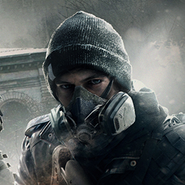
Segmentation agent concept art.
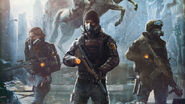
Division agents concept art.
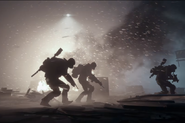
Division agents in a heavy snowstorm.

Concept fine art of Segmentation agents.

Concept art of Partitioning agents.

A Sectionalization amanuensis looking at an empty street.
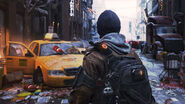
A Division agent looking at the emptiness in the street.

Ii Sectionalization agents roaming the street.
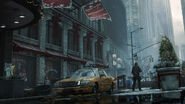
Concept fine art of a Division agent standing in the center of an empty street.
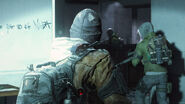
Three Sectionalization agents roaming inside the Brooklyn Police Station.

Division agents firing at rogue Division agents.

Division agents exchanging gunfire with Rikers.
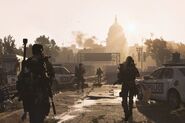
Division agents in Washington, D.C. roaming around Capitol Hill.
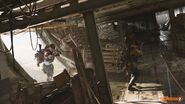
Partitioning agents roaming inside Air Strength One.
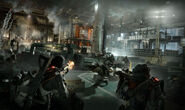
Division agents engaged in a gunfight with LMB forces in the incursion Falcon Lost.
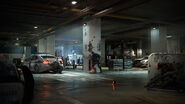
Partitioning agents are seen in cover in the garage of the Police Academy.
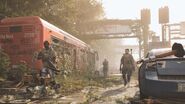
Sectionalisation agents roaming the street.
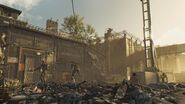
2 Partitioning agents inbound a Dark Zone Checkpoint.
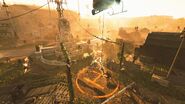
An amanuensis extracting their item in a extraction zone

A Partitioning agent requesting extraction whilst being protected by other 2 agents.
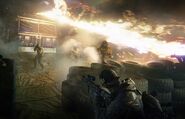
A Division agent firing his weapon at Cleaners during the incursion Dragon'southward Nest.
Concept art of Division agents standing around the entrance to Nighttime Zone South.
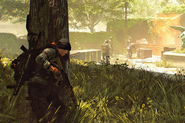
A Partitioning agent in Dark Zone East getting prepare to ambush a couple of enemies.
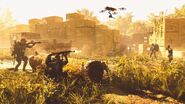
Partition agents in a gun boxing against members of the Hyenas.
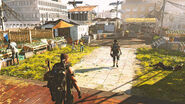
Division agents roaming around a fortified settlement.
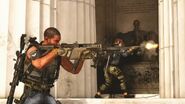
One Division agent aiming their weapon, whilst the other Division agent is firing their weapon.
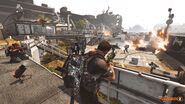
Segmentation agents in a gun battle with a Black Tusk Heavy Tank.
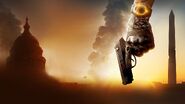
A Division agent with their Smart Watch and a handgun.
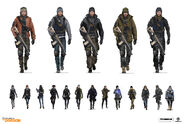
Concept art of Division agents for Tom Clancy's The Sectionalization.
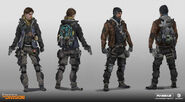
Female and Male Sectionalisation agent concept art for Tom Clancy's The Partition.
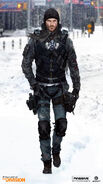
Partitioning agent concept art.

Division agents aiming their weapons during the raid on the Washington National Airport.

Division agents in a gun battle with Black Tusk forces.
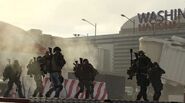
Partition agents heading into the Washington National Airport.

Division agents in the Undercover.
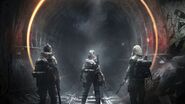
Concept art of Division agents entering the Surreptitious.


Division agents heading into Manning National Zoo.

Partition agents in White Camp Oak.

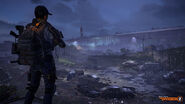

An agent taking a rest in the Theater Settlement.

Division agents in a gun battle with a Cleaner.

A Division agent in the Take Back New York Cinematic Trailer.
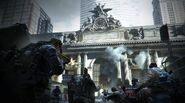
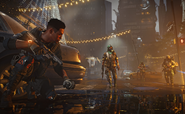
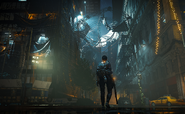
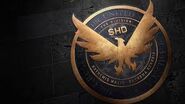
![]()
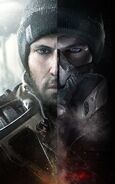
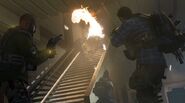
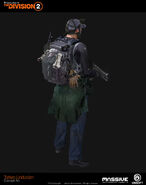
Male person concept art of Division agents for Tom Clancy's The Division two.
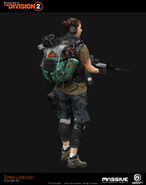
Female concept art of Segmentation agents for Tom Clancy's The Division 2.
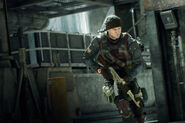

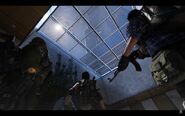
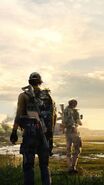
Trivia
- Nigh factions from Tom Clancy's The Division don't seem to be aware near the SHD presence in Manhattan. This is shown every bit enemy factions battling with Segmentation agents will refer to them as JTF or classify them equally civilians trying to be brave, and deploying skills merely catches them past surprise and confuses them.
- The only two factions that seem to know the true abilities of The Segmentation are the Joint Chore Forcefulness (who have been working very closely with The Partition) and the Final Man Battalion (who have Rogue Start Moving ridge agents on their side). But even for the latter, only the more aristocracy LMB know about The Partitioning, leaving the regular LMB unaware of The Partition.
- JTF soldiers are often complimenting Division agents as they pass by them in Manhattan, ofttimes joking near getting gun similar the agent'southward, saying that they'll be in their prayers, and thanking them for helping them out.
- Every bit of the introduction of the Underground and of Clear Sky, the Rikers accept started to catch on to the SHD presence in Manhattan, as Rikers obtained some new equipment from Sectionalisation agents for the Secure Quarantine mission and intercepted a V-22 Osprey loaded with SHD Tech (which Slider referred to as "Si-Fi Tech").
- Equally of one.8: Resistance, with the deployment of Segmentation agents to Westward Side Pier, simply then the factions knew well-nigh how much of a threat The Division posed to them, leading the LMB to banker a truce between the factions against The Division.
- Although dislocated, fearful and very scared, unarmed civilians recognize Division agents every bit good guys.
- The only two factions that seem to know the true abilities of The Segmentation are the Joint Chore Forcefulness (who have been working very closely with The Partition) and the Final Man Battalion (who have Rogue Start Moving ridge agents on their side). But even for the latter, only the more aristocracy LMB know about The Partitioning, leaving the regular LMB unaware of The Partition.
- By the fourth dimension of Tom Clancy's The Partition 2, The Division take fully established themselves, as this is shown that when engaging in most enemy factions usually taunt and threaten Division agents directly
- Hyenas view The Partitioning as potency figures in a non-disciplinarian world, oft directly threatening them and warning them to back off earlier "they get themselves killed" in their propaganda messages.
- Outcasts view The Sectionalisation as function of the reason they suffered in the Roosevelt Quarantine, threatening to assail them in their propaganda letters
- True Sons sometimes apply physiological warfare against The Sectionalisation, attempting to spread the bulletin that The Division should be feared because of ISAC (equally the advantages of the highly advanced AI is known but to Division agents). They besides try to convince Segmentation agents to go rogue and join their side through their propaganda letters.
- The Black Tusk are the nigh unsafe enemies The Sectionalization has come beyond, as they take covertly neutralized several agents in D.C. and caused the SHD Coma that sent all Division agents in the D.C. expanse to The White House.
- The JTF at the White House highly respect Partitioning agents, every bit watch guards oft salute agents walking by and quickly apologizing should they bump into them at anytime.
- The Noncombatant Militia (and the D.C. settlements in full general) fully support The Segmentation, as settlement members are heard complimenting agents as they walk past, and Militia soldiers often cheer agents on, even mentioning that children are pretending to exist agents and that settlement members have formed Partitioning fan clubs.
- Information technology is unknown if factions like the Underground and the Ambushers know about The Division.
- The Manhattan settlement Haven and their faction the Peacekeepers in Warlords of New York did not trust The Partition at commencement, with their leader Paul Rhodes even going as far as turning away a Division agent he knew from the by and kept her from inbound the settlement; this untrustworthy feeling only grew when Aaron Keener and his rogue agents showed up and started wrecking havoc on Lower Manhattan. Nonetheless, the ii factions eventually formed a mutual - albeit uneasy - alliance as the Division was slowly able to eliminate Keener and his lieutenants.
- According to the book The Globe of Tom Clancy'south The Division, one time activated, a Sectionalisation agent outranks every authorities agent and official in the Us, excluding the President and entire federal agencies
Appearances
- Tom Clancy'due south The Division
- Tom Clancy's The Division 2
Source: https://thedivision.fandom.com/wiki/Strategic_Homeland_Division
0 Response to "September Division2 P416 King Again Eb Dead"
Post a Comment